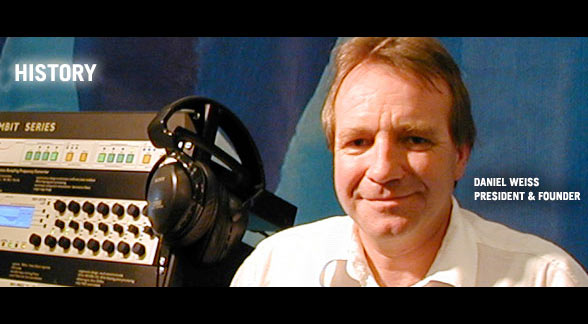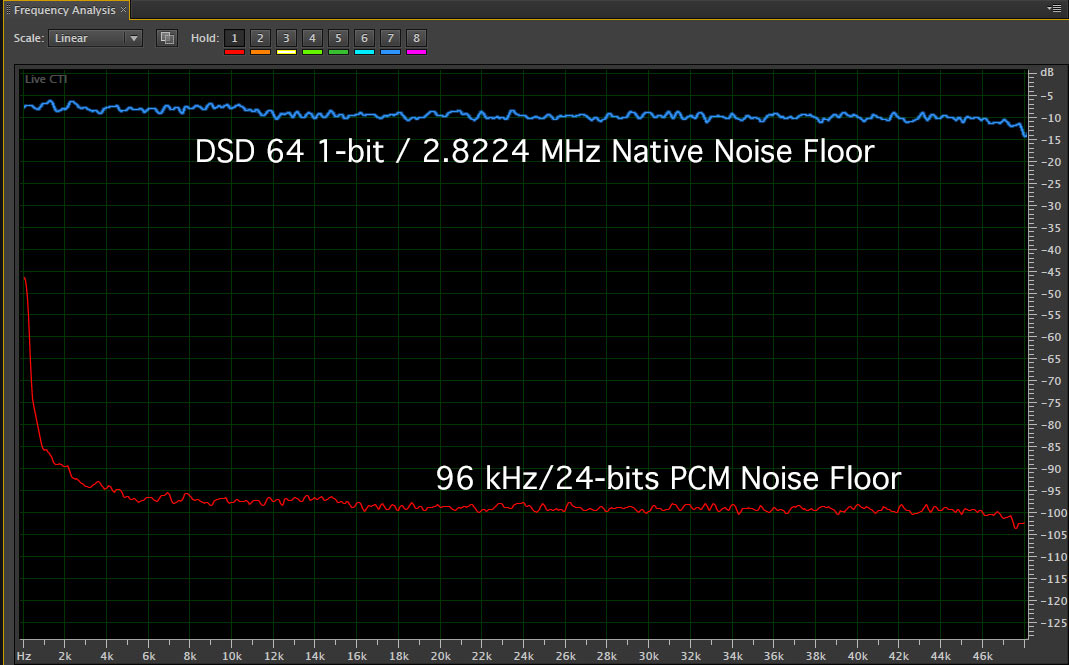Weiss On DSD…Gets It Right!
The first thing I noticed on my FB page this morning was a like from Morten Lynberg of 2L regarding a recent pdf white paper that was authored by Daniel Weiss, an experienced and very well-respected equipment designer and head of Weiss Engineering Ltd. After experiencing yesterday’s hyperbole and unreasoned enthusiasm about DSD from Chad Kassem’s SuperHiRez.com, it was refreshing to read something accurate and concise on the whole topic. I totally agree with his assessment and having been saying the virtually the same thing for years. I thought I would share his sentiments and make a few comments myself on the whole DSD thing. One more time with feeling…
Here’s the link to his article:
I do promise to get back to the SuperHiRez download that I completed this morning…but I’m struggling with spending $75 on the Audirvana digital player that will handle the DSD file. I really can’t justify spending that kind of money just to play a DSD file and find that it is identical to the 44.1/16-bit file that I ripped from my CD copy. I’ll get back to it after I figure out a solution.
The first section of Daniel’s paper is called Quantizing, which refers to the sampling rate and word sizes used in the digitization of an analog waveform into a stream of ones and zeros, the binary language that digital systems understand. He says:
DSD is a digital signal which uses a 1 bit quantization of the audio signal at a sampling rate of 64 times the sampling rate of a CD (64 x 44100 = 2.8224 MHz). The CD format uses a 16 Bit quantization at a 44.1 kHz sampling rate, thus the data rate of a DSD signal is 4 times the data rate of a CD, which gives the SACD the potential to represent the audio signal more precisely.
The tech guys at SuperHiRez might want to read this and edit their definition of DSD and include the word length rather than present the wrong numbers and focus only on the very high sampling rate of DSD!
Another key phrase used in the paragraph above is, “gives the SACD the potential” to improve on the specifications of a CD. Whether that potential is realized is up to the entire production chain…not just the delivery format. He continues:
The noise floor of a signal at 44.1kHz /16 Bit is about 16 x 6 = 96dB below full scale. With the DSD signal the noise floor is 1 x 6dB below full scale, so obviously there have to be taken some measures to get down the noise floor, else a DSD recording would be very noisy.
Here the high sampling rate of DSD comes in handy. I.e. with special filtering techniques (noise-shaping) it is possible to move the noise in the audio band (0…20kHz) out to higher frequencies above 20kHz. Thus the noise floor in the audio band can be brought down to very low levels (well below the 16 Bit noise floor of a CD) at the cost that the noise is at a fairly high level at frequencies above 20kHz.
Wow! Someone is actually acknowledging the realities of 1-bit encoding. This is reminiscent of John Siau’s interview when he points out that 1-bit native DSD before the noise shaping is implemented provides 6 dB of signal to noise ratio in its native form. A single digital bit handles 6 dB (See Figure 1 below).
Figure 1 – Spectra of the noise present in a 96 kHz/24-bit PCM recording and a native DSD 64 file. (Click to enlarge)
Look, I know this graph is unfair and doesn’t represent anything that you would ever experience but it is the situation prior to the noise shifting that is possible because of the very high sample rate. Sorry.
The second part of Daniel’s second paragraph lays out the case for DSD as a very good replacement for compact discs. When noise-shaping moves the noise out of the audio band (20 Hz…20 kHz) to a range above 20 kHz, the in band noise floor is better than CDs. Does the ultrasonic noise present a problem? Yes, it does as he states in the next section called “Filtering”.
This high level / high frequency noise has to be suppressed before the signal hits the amplifier and speakers, in order to avoid amplifier misbehaving and/or speaker blow-up. A low pass filter is used to suppress the noise. In a native DSD D/A Converter this low pass filter has to be implemented in the analog domain which can be problematic because the non-linear phase characteristics of such a filter. Alternatively this filter can be implemented in the digital domain where the DSD signal is converted to PCM (at e.g. 176.4 kHz / 24 Bit) and at the same time gets properly low pass filtered, e.g. with a linear phase filter which is easily achievable in the digital domain.
Speakers blowing up? Yep, the amount of non-correlated noise energy present in the ultrasonic bands has the potential of causing problems in your equipment. The fact is that it has to be removed. And this can happen in the analog domain after the conversion back from DSD to analog (with attendant problems of phase coherence) OR it can happen in the digital domain by converting to PCM at a very high sample rate (say 176.4 kHz/24-bits) as he correctly states.
He goes on to talk about the original uses or DSD as an archival and distribution format. As I have stated repeatedly, it is not suitable for production. Even Cookie of Blue Coast records to analog multitrack tape and then exports the final mixes to DSD for SACDs or DSD downloads. This is her choice and I can’t argue with it…she prefers the sound of analog. I don’t.
Under the processing section, Mr. Weiss acknowledges the difficulties of making records in DSD. The final sentence of that section says it all:
In such a case it does not make sense to do a recording in DSD to start with. A PCM recording at e.g. 88.2kHz / 24 Bit would make much more sense. After the production process the file can always be converted to DSD if required.
This mirrors the statements made by John Siau of Benchmark.
The final two area of the white paper hit the nail on the head:
What is better?
The discussion whether DSD is better than PCM is moot. DSD is another variant to store music, like PCM, MP3, magnetic tape, vinyl etc. All formats are fine as long as there are people preferring one over the other for whatever reasons. A matter of taste or practical reasons as with MP3 for instance.
Bravo! Well said…pick your own preferred formats. Just be aware of the facts associated with all of them.
He closes the piece with a discussion of the future:
Technically speaking, PCM from like 88.2kHz /24 bit up, is definitively better than DSD. There are attempts to enhance DSD by raising the sampling rate from 2.8824 MHz to 5.6448 MHz or even 11.2896 MHz. Some problems of DSD may be reduced with such measures, but the 1 bit quantization problem cannot be eliminated.
With the DSD downloads becoming more and more popular the DSD format is going to stay with us. A niche, but a growing one.
My hat is off to Mr. Weiss for writing such a concise and clear explanation of DSD and its impact on the world of high-end audio. His assessment is completely consistent with that of John Siau of Benchmark, Mike Moffit ex of Theta Digital and Jonathan Reichbach of Sonic Studio…and myself.
Thanks for Morten for passing this my way. Maybe we can stop arguing about the merits of DSD vs. PCM now and focus on the productions that good engineers are doing everyday.



Been using computer audio for a few years now, the incidents of white noise popping at the most inappropriate times was using players that sat on top of iTunes, playing PCM files. Two starting with A and one with P.
To date have not lost sync or blew speakers when using a DAC that converts everything to DSD, that’s now over 12 months, do I have to wait longer for this noise to wreck speakers?
How come I can listen to DSD for hours and with PCM it never reaches the same level of engagement.
DSD just sounds better, for whatever reason, High end DAC manufacturers realize this, and are handling PCM in the DSD domain in the Digital to analogue conversion.
DSD sounds nearly like a vinyl on a turntable, it’s such a rich and full bodied sound. there is no comparison between them, i don’t believe that PCM at the right bit / sample rate will ever sound like DSD.
i have 24 / 192khz music, and even 1x DSD sounds much better than that.. at least i have to say they sound very different these two formats, whether one prefers one or another, lets not get into that, but i can say with certainty that they have different sound characteristic’s these 2 ways of handling digital sound.
DAD sounds better to you. You’re entitled to you own opinion, fine. But plenty of others…including me…find otherwise. “DSD sounds nearly like a vinyl on a turntable” is a something I want in my listening. While I appreciate the nostalgia that vinyl LPs represent, the actual fidelity is highly compromised in comparison to a high-resolution PCM file. You can make a digital file sound like vinyl…but most people choose not to. It would be adding distortion, varying the speed, folding the low end to mono etc.
The was a rigorous study done that compared a new recording done in parallel to DSD and PCM. Guess what they found. The test subjects couldn’t identify the format of either one. Enjoy your library of vinyl and DSD recording but don’t try to convince those of us that prefer PCM that DSD “sounds better”. It doesn’t to us.